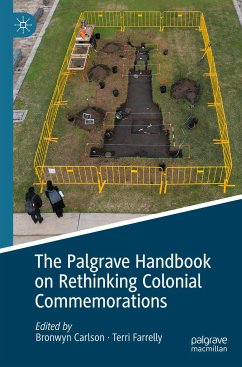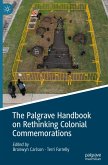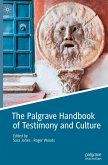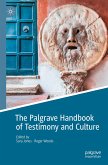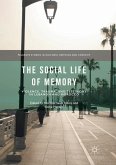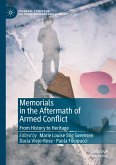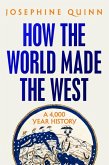The Palgrave Handbook on Rethinking Colonial Commemorations
Herausgegeben:Carlson, Bronwyn; Farrelly, Terri
The Palgrave Handbook on Rethinking Colonial Commemorations
Herausgegeben:Carlson, Bronwyn; Farrelly, Terri
- Broschiertes Buch
- Merkliste
- Auf die Merkliste
- Bewerten Bewerten
- Teilen
- Produkt teilen
- Produkterinnerung
- Produkterinnerung
The Palgrave Handbook on Rethinking Colonial Commemorations explores global efforts, particularly from Indigenous and Bla(c)k communities, to dismantle colonial commemorations, monuments, and memorials. Across the world, many Indigenous and Bla(c)k communities have taken action to remove, rectify and/or re-imagine colonial commemorations. These efforts have had the support of some non-Indigenous and white community members, but very often they have faced fierce opposition. In spite of this, many have succeeded, and this work aims to acknowledge and honour these efforts. As a current and…mehr
Andere Kunden interessierten sich auch für
![The Palgrave Handbook on Rethinking Colonial Commemorations The Palgrave Handbook on Rethinking Colonial Commemorations]() The Palgrave Handbook on Rethinking Colonial Commemorations186,99 €
The Palgrave Handbook on Rethinking Colonial Commemorations186,99 €![Nicolaus Copernicus in the Culture of Memory Nicolaus Copernicus in the Culture of Memory]() Nicolaus Copernicus in the Culture of Memory55,00 €
Nicolaus Copernicus in the Culture of Memory55,00 €![The Palgrave Handbook of Testimony and Culture The Palgrave Handbook of Testimony and Culture]() The Palgrave Handbook of Testimony and Culture149,99 €
The Palgrave Handbook of Testimony and Culture149,99 €![The Palgrave Handbook of Testimony and Culture The Palgrave Handbook of Testimony and Culture]() The Palgrave Handbook of Testimony and Culture149,99 €
The Palgrave Handbook of Testimony and Culture149,99 €![The Social Life of Memory The Social Life of Memory]() The Social Life of Memory82,99 €
The Social Life of Memory82,99 €![Memorials in the Aftermath of Armed Conflict Memorials in the Aftermath of Armed Conflict]() Memorials in the Aftermath of Armed Conflict97,99 €
Memorials in the Aftermath of Armed Conflict97,99 €![How the World Made the West How the World Made the West]() Josephine QuinnHow the World Made the West28,99 €
Josephine QuinnHow the World Made the West28,99 €-
-
-
The Palgrave Handbook on Rethinking Colonial Commemorations explores global efforts, particularly from Indigenous and Bla(c)k communities, to dismantle colonial commemorations, monuments, and memorials. Across the world, many Indigenous and Bla(c)k communities have taken action to remove, rectify and/or re-imagine colonial commemorations. These efforts have had the support of some non-Indigenous and white community members, but very often they have faced fierce opposition. In spite of this, many have succeeded, and this work aims to acknowledge and honour these efforts. As a current and much-debated issue, this book will present fresh findings and analyses of recent and historical events, including #RhodesMustFall, Anzac Day protests, and the transferral of confederate monuments to museums.
Comprising of chapters written by Indigenous, Bla(c)k and non-Indigenous authors, from a wide variety of locations, backgrounds and purposes, this topical volume is atimelyand important contribution to the fields of memory studies, Indigenous Studies, and cultural heritage.
Comprising of chapters written by Indigenous, Bla(c)k and non-Indigenous authors, from a wide variety of locations, backgrounds and purposes, this topical volume is atimelyand important contribution to the fields of memory studies, Indigenous Studies, and cultural heritage.
Produktdetails
- Produktdetails
- Verlag: Palgrave Macmillan / Springer International Publishing / Springer, Berlin
- Artikelnr. des Verlages: 978-3-031-28611-7
- 2023
- Seitenzahl: 652
- Erscheinungstermin: 2. Juli 2024
- Englisch
- Abmessung: 235mm x 155mm x 35mm
- Gewicht: 973g
- ISBN-13: 9783031286117
- ISBN-10: 3031286111
- Artikelnr.: 71212692
- Herstellerkennzeichnung
- Springer Nature c/o IBS
- Benzstrasse 21
- 48619 Heek
- Tanja.Keller@springer.com
- Verlag: Palgrave Macmillan / Springer International Publishing / Springer, Berlin
- Artikelnr. des Verlages: 978-3-031-28611-7
- 2023
- Seitenzahl: 652
- Erscheinungstermin: 2. Juli 2024
- Englisch
- Abmessung: 235mm x 155mm x 35mm
- Gewicht: 973g
- ISBN-13: 9783031286117
- ISBN-10: 3031286111
- Artikelnr.: 71212692
- Herstellerkennzeichnung
- Springer Nature c/o IBS
- Benzstrasse 21
- 48619 Heek
- Tanja.Keller@springer.com
Professor Bronwyn Carlson is an award-winning Aboriginal author, researcher and academic who lives on Dharawal Country in New South Wales. Bronwyn is the author of The politics of identity: who counts as Aboriginal today? (2016) and a well-known commentator on the place of colonial monuments. She is a co-author of Monumental Disruptions: Aboriginal People and Colonial Commemorations in So-Called Australia (2023). She is the founder and editor of The Journal of Global Indigeneity and the Director of the Centre for Global Indigenous Futures, Head of the Department of Indigenous Studies at Macquarie University and a Fellow of the Australian Academy of the Humanities. Dr Terri Farrelly is an Adjunct Fellow and Postdoctoral Research Associate with the Department of Indigenous Studies at Macquarie University. She is a settler researcher and author whose work has been dedicated to Aboriginal suicidologies and addressing racism and discrimination through truth-telling. She is a co-author of Monumental Disruptions: Aboriginal People and Colonial Commemorations in So-Called Australia (2023).
Chapter 1. Introduction.- Part I: RECOGNITION & REMEMBERING.- Chapter 2. Memorials to settler colonialism in Australia: racism, colonialism and white power.- Chapter 3. Koro and the statue: disrupting colonial amnesia and white settler sovereignty in Aotearoa New Zealand.- Chapter 4. Space and place: cultural heritage and colonial commemoration at Australian tertiary institutions.- Chapter 5. Toppling the racist Anglo-Saxon politics of Cecil Rhodes.- Chapter 6. The dark side of Canadian history: a two-eyed seeing approach.- Chapter 7. "It's not a day for you": Indigenous Australians and the 'disruption' of Anzac Day.- Chapter 8. Reflections on Representation, Remembrance and the Memorial.-Chapter 9. Lest we forget: the Tunnerminnerwait and Maulboyheenner saga.- Chapter 10. Unwanted Endeavours and the reconstruction of Cook's world.- Chapter 11. How churches are framed and presented in the contemporary Sámi homeland of Finland to maintain colonial discourses.- Chapter 12. Colonial histories and artefacts: which way gender?.- Chapter 13. Monumental copper and coal: the case for including extractivism in the rethinking of colonial commemorations.- Part II: RESISTANCE & REIMAGINING.- Chapter 14. Holding dissonance, while disrupting narratives.- Chapter 15. Reason and reckoning: provocation and conversations about re-imaging Samuel Griffith's University.- Chapter 16. Comedic interventions: toppling monuments and dismantling myths in Rutherford Falls.- Chapter 17. Confederates and colonial commemoration in the United States: collective memory and counter-histories.- Chapter 18. The art of Daniel Boyd: decolonising Banks and Cook, challenging colonial commemoration.- Chapter 19. Asserting Indigenous agencies: constructions and deconstructions of James Cook in Northern Queensland.- Chapter 20. Futuring ruins: the grassroots design activism of the Department of Homo Affairs.- Chapter 21. 'It's just always been there': Rutherford Falls, monuments and settler colonial hegemony.- Part III: REMOVAL & RECTIFICATION.- Chapter 22. The need for context: archaeology's contribution to the 'statue wars'.- Chapter 23. Dis-placing white supremacy: intersections of Black and Indigenous struggles in the removal of the Roosevelt statue at the American Museum of Natural History.- Chapter 24. Edifying: the Deathscapes Project and the landscape of settler-colonial monumentality in Australia.- Chapter 25. The problem and potential of anti-Black monuments in museums.- Chapter 26. Local Empire: George Frampton's Leeds Queen Victoria Memorial.- Chapter 27. The struggle continues down south: dismantling of colonial monuments and symbols of colonialism and white supremacy.- Chapter 28. Standing strong: the renaming of Toronto Metropolitan University.-Chapter 29. The 'Crowther Reinterpreted' project.- Chapter 30. You can handle the truth: Aboriginal peoples, colonial commemorations and the unfinished business of truth-telling.
Chapter 1. Introduction.- Part I: RECOGNITION & REMEMBERING.- Chapter 2. Memorials to settler colonialism in Australia: racism, colonialism and white power.- Chapter 3. Koro and the statue: disrupting colonial amnesia and white settler sovereignty in Aotearoa New Zealand.- Chapter 4. Space and place: cultural heritage and colonial commemoration at Australian tertiary institutions.- Chapter 5. Toppling the racist Anglo-Saxon politics of Cecil Rhodes.- Chapter 6. The dark side of Canadian history: a two-eyed seeing approach.- Chapter 7. "It's not a day for you": Indigenous Australians and the 'disruption' of Anzac Day.- Chapter 8. Reflections on Representation, Remembrance and the Memorial.-Chapter 9. Lest we forget: the Tunnerminnerwait and Maulboyheenner saga.- Chapter 10. Unwanted Endeavours and the reconstruction of Cook's world.- Chapter 11. How churches are framed and presented in the contemporary Sámi homeland of Finland to maintain colonial discourses.- Chapter 12. Colonial histories and artefacts: which way gender?.- Chapter 13. Monumental copper and coal: the case for including extractivism in the rethinking of colonial commemorations.- Part II: RESISTANCE & REIMAGINING.- Chapter 14. Holding dissonance, while disrupting narratives.- Chapter 15. Reason and reckoning: provocation and conversations about re-imaging Samuel Griffith's University.- Chapter 16. Comedic interventions: toppling monuments and dismantling myths in Rutherford Falls.- Chapter 17. Confederates and colonial commemoration in the United States: collective memory and counter-histories.- Chapter 18. The art of Daniel Boyd: decolonising Banks and Cook, challenging colonial commemoration.- Chapter 19. Asserting Indigenous agencies: constructions and deconstructions of James Cook in Northern Queensland.- Chapter 20. Futuring ruins: the grassroots design activism of the Department of Homo Affairs.- Chapter 21. 'It's just always been there': Rutherford Falls, monuments and settler colonial hegemony.- Part III: REMOVAL & RECTIFICATION.- Chapter 22. The need for context: archaeology's contribution to the 'statue wars'.- Chapter 23. Dis-placing white supremacy: intersections of Black and Indigenous struggles in the removal of the Roosevelt statue at the American Museum of Natural History.- Chapter 24. Edifying: the Deathscapes Project and the landscape of settler-colonial monumentality in Australia.- Chapter 25. The problem and potential of anti-Black monuments in museums.- Chapter 26. Local Empire: George Frampton's Leeds Queen Victoria Memorial.- Chapter 27. The struggle continues down south: dismantling of colonial monuments and symbols of colonialism and white supremacy.- Chapter 28. Standing strong: the renaming of Toronto Metropolitan University.-Chapter 29. The 'Crowther Reinterpreted' project.- Chapter 30. You can handle the truth: Aboriginal peoples, colonial commemorations and the unfinished business of truth-telling.

